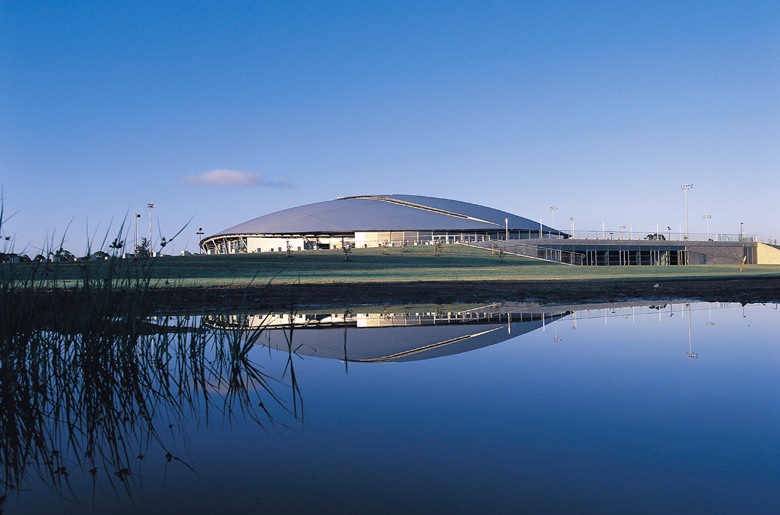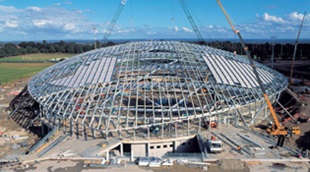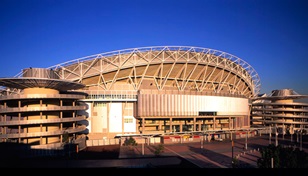Dunc Grey Velodrome, Sydney
The track cycling venue for the Sydney 2000 Olympic Games won a national award for Sustainable Architecture in 2001 for its environmental efficiency.
Credentials:
Architect: Paul Ryder, Ryder SJPH PartnershipEngineer: Arup and Partners
Builder: Walter Construction Group
Cladder/Roofer: Axis Metal Roofing
The Royal Australian Institute of Architects (RAIA) has awarded the Dunc Grey Velodrome its national award for Sustainable Architecture.
In a world first, curved Cee purlins manufactured from GALVASPAN® steel were used in conjunction with curved structural steel and steel cladding to create the distinctive domed shell of the Dunc Grey Velodrome at Bankstown in Sydney.
The RAIA award recognises buildings that acknowledge all opportunities to harvest, use, re-use or recycle on-site resources during their life.
The judges said the velodrome's evocative but simple form recalled a cyclist's helmet. The architect has used this geometry to benefit the requirement for a passively ventilated space.
"A suite of natural ventilation and lighting concepts has been successfully integrated into the architecture of the building with considerable skill," the panel said.
"The Velodrome's environmental efficiency is further demonstrated through the vast internal space enclosed by a light, latticed steel structure of inventive economy."
The 11,000 square metre Olympic Velodrome incorporates a range of new construction techniques.
Curved light steel purlins made from GALVASPAN® steel create the Velodrome's distinctive shell-shaped roof structure.
In a world first, pairs of back-toback cold-formed 250mm deep LYSAGHT® CEE purlins were used to span the 11 metres from arch to arch.
"The curving process was developed by BlueScope Steel specifically for this project and is now available for specification on other buildings," said engineer Peter Bailey of Arup, structural engineers for the project.
"This is the largest and most innovative grid shell structure ever built in Australia from steel.
"The roof was assembled by lifting large sections into place without any props in the middle of the building – another world first," Mr Bailey said.
"This left the building's interior completely free for other work to continue while the roof was being constructed, saving time and cost."
Architects Ryder SJPH Partnership developed the Velodrome design in conjunction with consulting engineers Arup.
Paul Ryder said the shape of the striking form of the roof grew from the geometry of the shell.
It is covered by ZINCALUME® zinc/aluminium alloy coated steel rollformed into LYSAGHT LONGLINE 305® sheeting in specifically tapered lengths of more than 24 metres.
"I wanted to express the fact that it's a very large suspended roof, symmetrical except that it's stretched out at one end to create a foyer area," said Paul Ryder.
"We decided to stretch the roof forward to give it a directional look – as though it's going somewhere.
"The roof resembles a round, dynamic flying saucer-type object that will use its ZINCALUME® steel finish to reflect the colour of the sky."
Glazed central skylights with light control louvres optimise natural lighting.
A heat stack running 110 metres along the roof's entire length creates convection to suck out hot air, which is replaced by cooler air entering underneath spectator seating.







